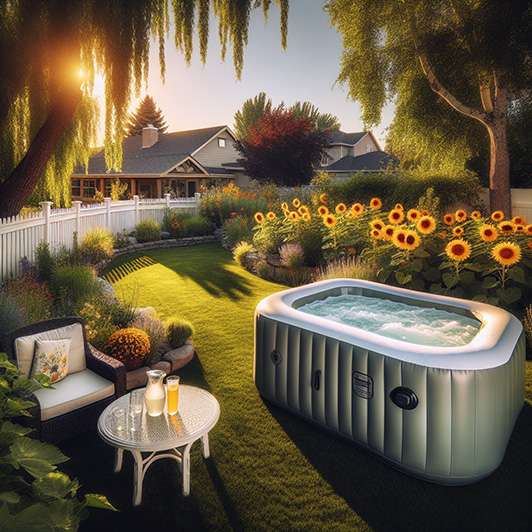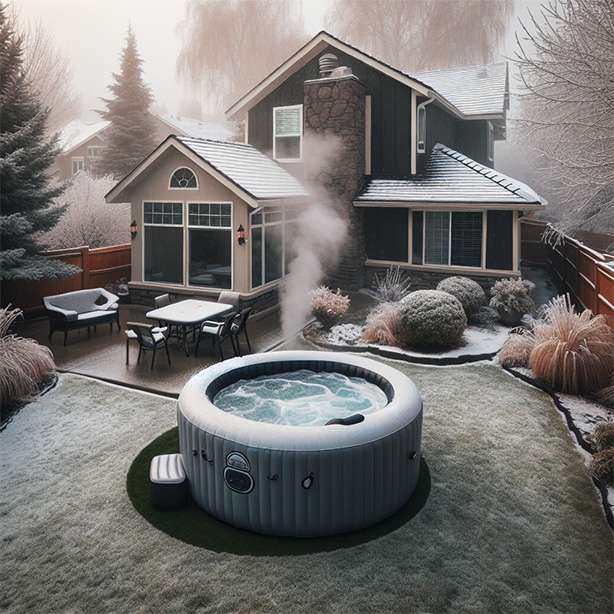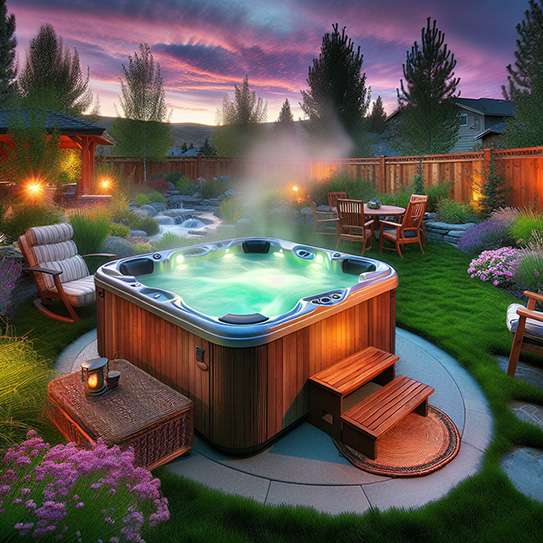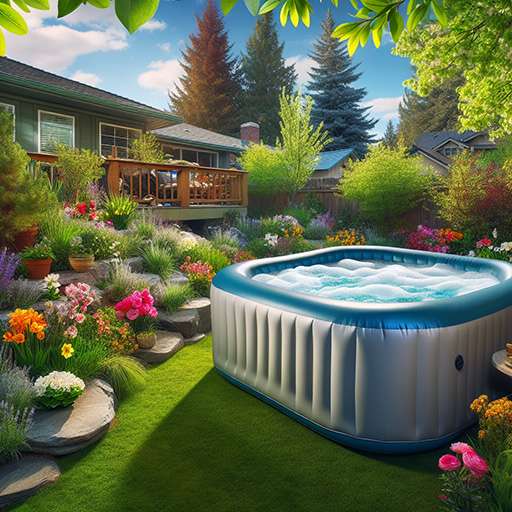If you’re considering adding the luxury of a hot tub to your home this year, an inflatable model might be on your radar. Inflatable hot tubs are known for their affordability and convenience, but they come with unique features and challenges that are important to understand. Let’s dive deeper into what owning an inflatable hot tub entails, ensuring you’re well-informed before deciding.
Costs of Inflatable Hot Tubs
Inflatable hot tubs are attractive for their low initial purchase price but also have several ongoing costs. These include expenses for electricity, which powers the heating system, chemicals for maintaining water quality, and occasionally replacing parts like filters or repair patches. These costs can increase with frequent use.
While inflatable hot tubs can be more expensive to operate due to their less efficient insulation, the exact cost will vary based on factors like usage frequency, local energy prices, and how well the tub is maintained. Generally, traditional hot tubs offer better energy efficiency, which could result in lower operating costs in the long term.

The decision between an inflatable and a traditional hot tub should consider these operational costs against the upfront savings offered by an inflatable model.
Setting Up Your Inflatable Hot Tub
Inflatable hot tubs offer quick setup, usually requiring no tools. To avoid damage, they need a flat, sturdy surface free of sharp objects. They must also be close to a power outlet and water source, which could limit placement options. The setup process typically lasts 5-15 minutes, with filling taking 1.5 to 3 hours based on water pressure and tub size. Heating the water may take 12 to 24 hours. Once set up and heated, you must balance the chemicals before your hot tub is ready for enjoyment.
Weight Considerations and Safety
Despite their portability and easy setup, inflatable hot tubs can be heavy when filled. They can weigh over 2,500 lbs, requiring a solid base to prevent damage to the surface below.
Safety is also crucial, particularly for families with young children. Inflatable hot tub walls are typically only 25 to 42 inches high, which toddlers might easily climb over, creating a risk of falling into the water. Additionally, the covers often have weak straps that a child could easily undo, increasing the risk of drowning.
Advantages and Comfort Considerations
Inflatable hot tubs are incredibly convenient for renters or those who move frequently. They allow for easy relocation, so you can take your hot tub when you move.
Comfort-wise, these hot tubs lack built-in seats. Instead, users sit on a padded floor, which may not offer the ergonomic support some prefer. You can buy additional inflatable seats or cushions for more comfort.

Also, consider the capacity of inflatable hot tubs. While many claim to fit four to six people, the space might feel tight, particularly regarding legroom and personal space. They are often more comfortable for fewer people.
Maintenance and Durability
The lifespan of an inflatable hot tub can range from three to ten years, depending on maintenance. Regular cleaning and careful handling are crucial to extend its life. Be aware of possible issues like punctures or pump failures.
Inflatable hot tubs generally have less robust water filtration systems than hard-shell models. This can lead to poorer water quality, requiring frequent water changes and chemical treatments. Regular maintenance is essential to maintaining safe water quality, but it could increase ongoing costs and effort.
Manufacturers usually provide limited warranties for only a year. Having access to customer support and readily available repair kits or parts is essential.
Challenges with Parts and Service
One often overlooked practical concern is the availability of parts and repair services for inflatable hot tubs. Many local dealers do not stock these parts, making repairing or replacing major components difficult and costly. The lack of readily available parts can be a significant drawback for those looking for a low-maintenance and easily serviceable hot tub solution.
Energy Efficiency and Seasonal Use
Heating efficiency is a critical but often overlooked aspect of inflatable hot tubs. These tubs have heaters that warm the water slowly, about 1-3 degrees Fahrenheit per hour. It can take up to 24 hours to heat the water from a cooler starting temperature, such as 55°F, to the optimal 104°F, especially if filled with cold tap water.

Additionally, maintaining the desired temperature becomes more challenging as the external temperature drops. Below 40°F, the hot tub’s insulation, which is generally less efficient than hard-shell models, struggles to retain heat. This leads to significant heat loss, making the heater work harder and longer to maintain the temperature and thus increasing energy consumption.
Air Bubble Jets
Air bubble jets in inflatable hot tubs create a relaxing experience by circulating air through the water. These jets use a blower to push air into the tub, which forms bubbles. The bubbles rise to the surface, creating a gentle, massaging effect. This system is less complex than the water jets in traditional hot tubs, which can provide more intense massage but are more expensive and complex to maintain. Air bubble jets offer a soothing, light massage suitable for casual relaxation. They are a key feature in inflatable hot tubs, contributing to their appeal to those seeking a simple, portable relaxation solution.
The Noise

Inflatable hot tubs can be noisier than traditional hard-shell models due to their air pumps and heating systems. These systems are crucial for operating the tub and its bubble jets and can produce noise up to 70 dB—similar to a washing machine. The specific whining, turbine-like noise can be particularly disruptive and may affect the calm typically expected from hot tub relaxation. Understanding the noise levels of inflatable hot tubs is important to determine if they meet your need for quiet and tranquility.
Conclusion
Inflatable hot tubs are affordable, easy to use, and flexible, making them appealing in 2024. Yet, they come with challenges like installation, maintenance, seasonal use, and safety. Understanding these aspects will help you decide if an inflatable hot tub suits your relaxation needs. For further insights and comparisons between inflatable and traditional hot tubs, feel free to check out our article, “Inflatable Hot Tubs VS Traditional Hot Tubs: What You Need To Know.”
Are you looking for a durable and luxurious relaxation option? Check out Love’s Hot Tubs for traditional, high-quality hot tubs that fit your lifestyle and décor. Our hot tubs offer superior durability and comfort, perfect for adding a touch of luxury to your home. Visit Love’s Hot Tubs today to see how to make every day a spa day. Choose excellence; choose Love’s Hot Tubs.

References and Further Reading
-
- “Questions About Inflatable Spas” – Swiming Pool Steve.
- Bathtubber. (2023). “Inflatable Hot Tubs: 16 Pros And Cons & Product Picks! | 2024.” By Shana Burg.
- Happy Home Request. “Are Inflatable Hot Tubs Worth It? (+11 Questions Answered).” By David Miller.
- Top Ten Reviews. (2024). “Best Inflatable Hot Tubs 2024: Your Very Own Backyard Spa Without Blowing The Budget.” By Alex Temblador.
- Popular Science. (2023). “The Best Inflatable Hot Tubs of 2024.” By Stacey L. Nash.
- Home Pool World. “12 Pros And Cons Of Inflatable Hot Tubs (Are They Worth It?).” By Jed Arnold.
- Hot Tub Owner HQ. (2019). “Are Inflatable Hot Tubs Worth It? (What You Need To Know!).” By Jeff Campbell
- Domino. (2023) “This Inflatable Hot Tub Is Getting Me Through the Cold, Dark Days Of Winter.” By Andie Diemer.
- Leslies Pool. “The Definitive Guide To Inflatable Hot Tubs.” By Matt Giovanisci, Swim University.
- Simple Inflatables. “Inflatable Vs. Regular Hot Tubs: Complete Comparison Guide 2024.” By Simple Inflatable Staff.
- Pool Advisors. “Inflatable Vs. Regular Hot Tubs: The Ultimate Relaxation Showdown.”
- Storables.com. (2024). “How Much Electricity Does A Inflatable Hot Tub Use.” By Emily Roberts

